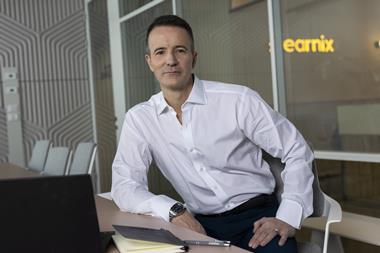The insurer is focused on ‘increasing the appetite of our products so that brokers can really trade from the micro to the larger SMEs on the same platforms’
Corinne Pringle, eTrade development manager at QBE, believes the insurer has achieved a raft of firsts when it comes to eTrading with brokers.
She tells Insurance Times that QBE was among the first to adopt live chat functionality and that the firm also led the way in offering contractors’ combined policies via software house Acturis.
In March this year, QBE looked to innovate further by increasing the fleet numbers that can be eTraded – now, new fleets of up to 20 vehicles can be eTraded.

Pringle says: “25 years ago, nobody would have thought you could insure a 20-vehicle fleet in an eTrade operation. It is possible - we can do it, we are doing it.
“I’m passionate about eTrade. It’s amazing to see that today you can buy 20-vehicle motor fleet [insurance] as quickly as you can buy your own personal car insurance.
“It is just amazing being able to use technology advances to give [a good] service and bring intelligence. We are bringing more data enrichment into our products to [improve the way] we handle referrals within the algorithm.
“We will keep reviewing and evolving [eTraded] products - we will push the boundaries of eTrade into larger, more complex risks across the board of our products.”
QBE’s passion for eTrading was rewarded with an overall four star rating from brokers for its extranet service in Insurance Times’ Five Star Rating Report: ETrading 2022.
Published in May 2022, the report revealed that QBE’s Fastflow platform ranked in third place with a score of 3.94 – a 0.01 increase on its 2021 result.
Pringle says this rating is a reflection of the service consistency that brokers get when they contact QBE. She explains that this ethos is underpinned by the insurer’s continuous improvement programme, which runs in parallel with regular reviews and listening to brokers.
She adds: “We have to make sure that we’re still relevant, but there’s no knee-jerk reaction to making radical changes. It is not about not changing - it is about being consistent with the service.
“Brokers have definitely evolved in the way they are using eTrade services from insurers.
“We must make sure we stay relevant and we have shown over the years that we have done a lot to allow brokers to continue trading the complex risks, the niche risks that QBE offers, which are not necessarily easy to find on an eTrade basis.
“We’d like to see brokers be able to go a step further into niche, specialist and complex areas while we grow and improve the products that we sell.
“One of the things we are definitely doing is increasing the appetite of our products so that brokers can really trade from the micro to the larger SMEs on the same platforms.”

Frictionless experience
QBE achieved another four star rating for its performance via a software house, to rank in joint third place alongside NIG (3.88) out of the insurers listed.
QBE aims to ensure that brokers have a frictionless experience regardless of the route they choose to trade.
For example, its tradesman product now has a 3% referral rate, meaning that brokers know straightaway that they will get a direct yes or no answer for the risk.
Pringle says: “It is about really choosing where we want to talk to a broker on specific cases and letting the machine handle everything else.

“It is not just about us wanting to speak to [brokers] to get more information - it is also about them and helping them to choose the right trade or business description.”
With this in mind, Pringle says QBE is using “more intelligence” to manage its eTrading function, supported by underwriters “who have designed the product” and have the ultimate decision in whether the broked risk should be accepted, declined or referred.
“It is really important that our staff are very well trained and understand what’s behind the system and [that] they are consistent in the way that they speak to the broker and manage the referral,” she adds.
Communicating with brokers
This year’s Five Star Rating Report: ETrading found that 41% of the 820 brokers polled have to wait more than two days for a referral to be cleared on complex product, while 33% have to wait one day.
Pringle says it is not always straightforward to reduce these waiting times.
She explains: “It is inherent to the types of risk and if we didn’t have these referrals, we would have more declines, which wouldn’t satisfy the broker.
“We want to provide the ability for brokers to remain in the system and to quote on that complex risk.
“We are having more brokers going through that have moved into the B2C environment for their micro business, which then pushes their approach to more complex risk.”
It is the “volume” and “complexity” of these types of risks that adds to referral waiting times, Pringle notes.
She continues: “Maybe brokers are used to their more traditional risks being handled within minutes - they expect the more complex risks to be handled in the same time frame, yet you require the conversation and they do value the conversation.”
QBE has also streamlined its cyber product by creating a quick quote approach. This allows the broker to first answer a few questions to try and get a quote. If this isn’t possible, they are then moved to answer the full question set.
Pringle says: “It is a two-stage approach that allows the micro business to place on the enhanced question set and then build into a more complex question set for more complex risks. We are looking at this more widely. Having that larger scale of business on eTrade does definitely push the [benefits of this model].”
Insurance Times’ survey also showed that brokers are frustrated with waiting times on live chat, as well as the response times of insurers generally - they are calling for more interaction with insurers.
To meet this demand, QBE has trained its underwriters to manage three live chats at a time.
Pringle says: “More complex business is more difficult to discuss over live chat, so often it starts as a live chat [and] then gets taken onto the phone.
“It’s great because people want to have different ways of contacting their insurer. The older and younger generations have different ways that they want to interact with their insurers. We have to be able to provide all those means.”













































No comments yet